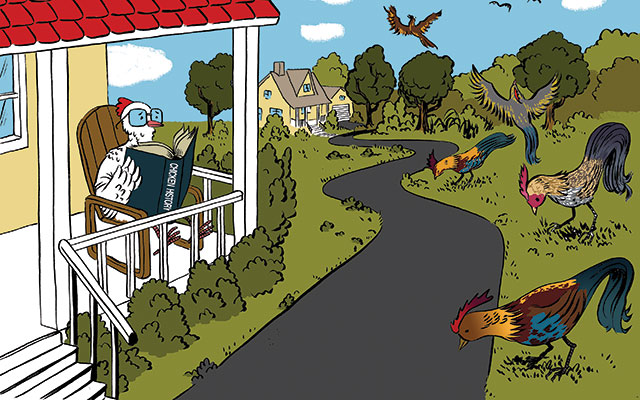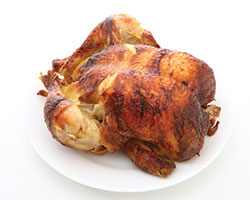Who knew that chickens could be so fascinating? I’ve been staying up late at night, engrossed in Andrew Lawler’s Why Did the Chicken Cross the World?: The Epic Saga of the Bird That Powers Civilization, and I must say, I had no idea.
I have eaten hundreds of chickens in my day, and am only now realizing how little I knew about them. I suspect most people are just about as ignorant as me.
Today, there are 20 billion — yes, with a “b” — chickens on Earth. That’s more than all the world’s cats, dogs, pigs, cows, and rats combined.
And Lawler makes a good case that without chickens, there would never have gotten to be 7 billion of us people on Earth.
Why? Because chickens provide the eggs that allow us to create vaccines. Chicken eggs are generally free of antibodies and full of food for viruses; without them we would still be vulnerable to flu pandemics like the one of 1918–1919 that killed nearly 675,000 Americans and 50 million people worldwide.
Chickens helped Charles Darwin imagine evolution, thanks to a mania for breeding exotic chickens that gripped England and the United States in the 1840s and 1850s. This chicken fad was called The Fancy, and during this frenzy of breeding, the modern chicken was born.
You’d recognize that chicken. It’s the one that can lay an egg a day, gains weight fast on grain, and tastes great quickly roasted. It’s the chicken that gets to slaughter weight in six weeks, the chicken of McNuggets and pourable egg whites — it’s the industrialized chicken that came about during World War II.
This is the ubiquitous, highly edible chicken that many of us have come to know and love. But for the first few thousand years humans had chickens by their side, the chicken was something else entirely.
This bird was once a wild animal native to the humid jungles of Southeast Asia. A skittish creature, it looked more like a wild pheasant than the white fluffy thing many of us picture today.
Originally, it was mainly a deep red-brown color; nowadays, we call it the red jungle fowl, though any remaining ones in Asian jungles have likely had their genetics corrupted by interbreeding with their domesticated cousins, which now vastly outnumber them.
Humans first used chickens for religious purposes. We can imagine those uses today because of indigenous people of Southeast Asia who continue to utilize the birds this way.
The Palaung people of Burma, Laos, and Vietnam still keep chickens, but not for food. Instead, they use the fowl’s inner organs and bones for fortunetelling and contacting the spirit world.
The Karen people of northern Burma sacrificed chickens to satisfy spirits who were bringing ruin to a family, such as blighting the crops, and used the bones for divination.
When the chicken spread east to the Pacific Islands from its native range, humans began to use its fine bones for sewing and tattooing.
When they went west to Greece, chickens were primarily used in religious sacrifice.
After he drank his cup of hemlock, Socrates’s last words are said to have been, “We owe a cock to Asclepius. Pay the debt. Don’t forget.”
Apparently, sacrificing a rooster to Asclepius, the Greek god of healing and medicine, was something done by people who wanted to get well.
Cockfighting was the thing in medieval England. King Henry VIII built a theater called the Cockpit-in-Court right inside London’s Whitehall Palace — much as a modern millionaire might install an in-home theater — so that he could have cockfights comfortably at home and not have to brave public venues.
There were many such public theaters for cockfighting: Shakespeare’s own Globe was built mainly for cockfighting. (In Henry V, the chorus wonders if the audience can imagine the stage as something for people: “Can this cockpit hold the vasty fields of France?”)
British villages were often built around cockfighting pits, and thousands of birds were housed exclusively for the sport, in which roosters were fitted with metal spurs, worked into a frenzy by their handlers, and allowed to fight to the death. Yikes.
[callout]If we lose the chicken’s place in our world, do we lose our own?[/callout]Meanwhile, common people were forbidden by law from engaging in such dangerous pastimes as tennis, cards, dice, bowling, and skittles.
Why did the powers that be consider tennis bad and cockfighting good? Partly because the spectacle of cockfighting was thought to make mankind more courageous and industrious. “It is wonderful to see the courage of these little creatures, who always hold fighting on till one of them drops, and dies on the spot,” wrote Daniel Defoe in 1724.
When England banned cockfighting in 1833, it wasn’t out of concern for the birds. Instead, it was because of worries about the culture of the rings, where pickpockets and public drunkenness were rampant.
There are countless such anecdotes in Lawler’s book, and so you can understand why I’m up late reading it. If you want to have your mind permanently blown, chickenwise, I can’t recommend the volume enough.
In fact, I would argue that having our minds blown, chickenwise, is something that would benefit us all.
How accustomed have we all become to this easy land of milk, honey, and chickens?
The chickens we eat come to us immaculately prepared: They’re boneless and enrobed in golden coatings as McNuggets. They are on sale on “rotisserie Wednesdays” in grab-and-go bags. Or, free-range and organic, they’re available at the market, cleanly butchered, and ready to roast at home.
In fact, edible chicken is now so common, so easy, so ubiquitous — have we forgotten these birds were ever alive? Do we eat them with any sense that they had an ecology, an environment, a trajectory all their own? And if we lose the chicken’s place in our world, do we lose our own?
The science of the last few decades is unequivocal: People are healthier when we eat plenty of bright and lively plants, mimicking our forager origins. We are healthier when we feel connected to our world, and to a purpose bigger than ourselves.
I’d humbly suggest that seeing chickens in their own wild and historical context gives us a perspective that allows us to break the cycle of eating buckets of fried chicken unthinkingly.
After reading Lawler’s book, I will never look at my coq au vin the same way again — and I’m grateful for the opportunity to see that clucking little part of modern life afresh.




This Post Has 0 Comments